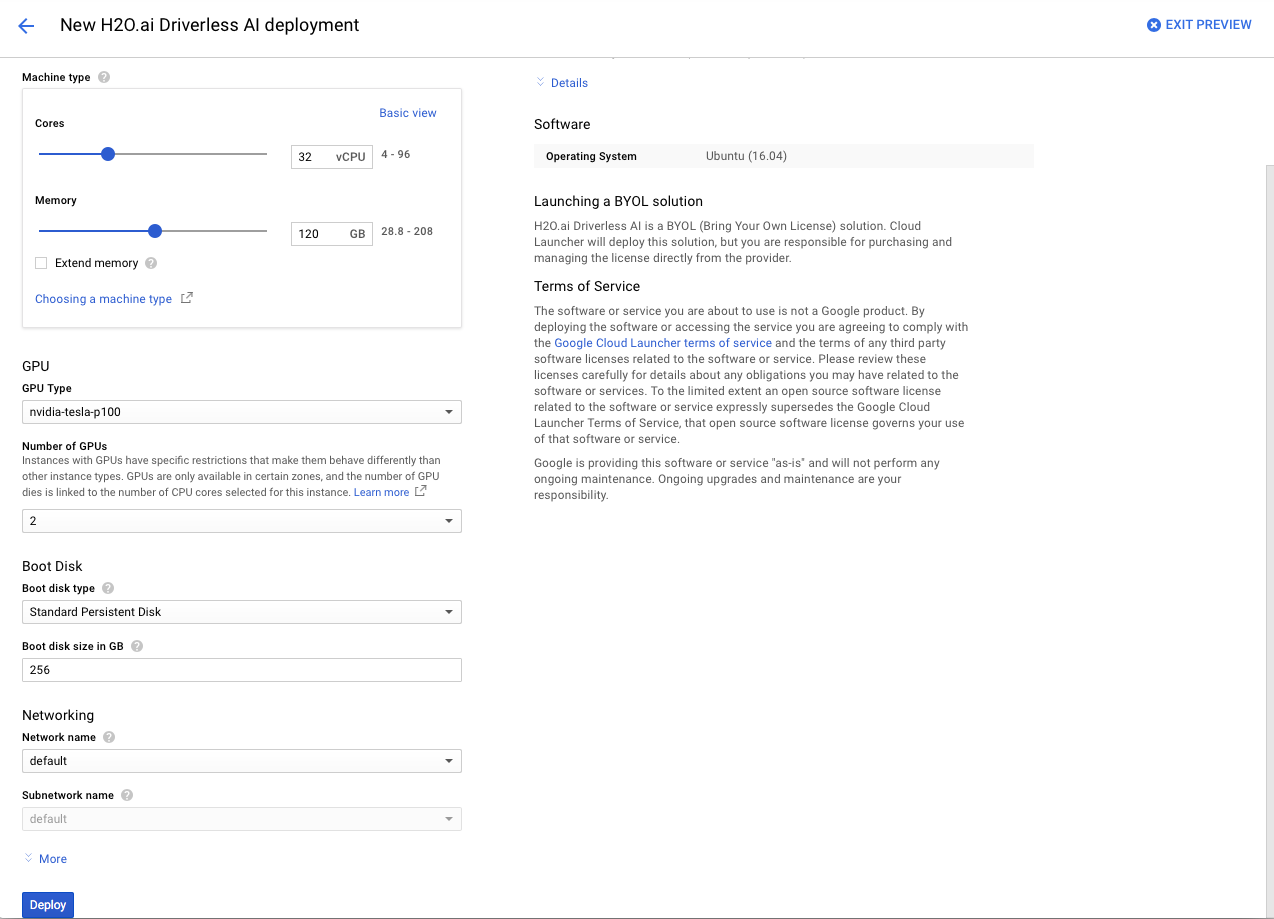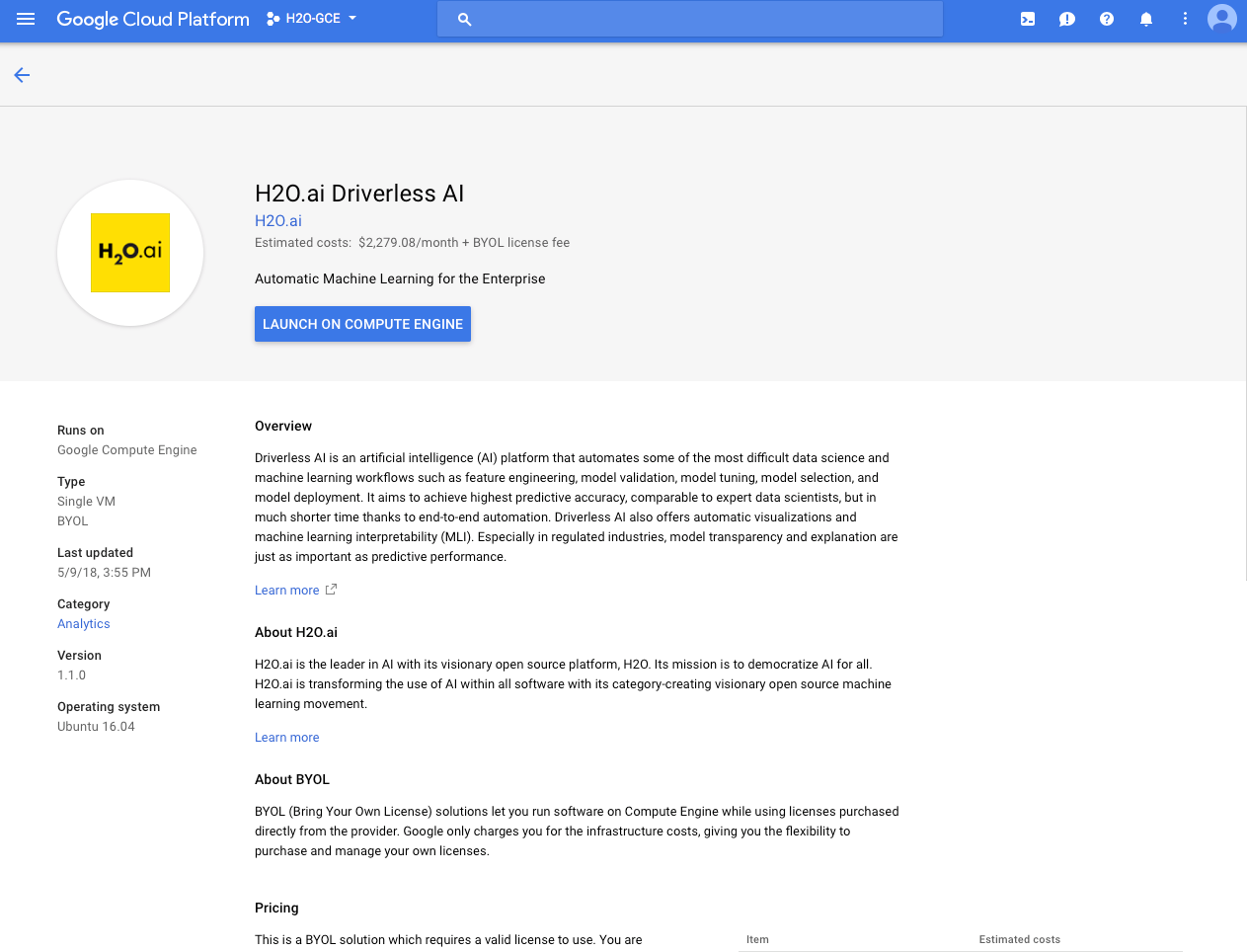Install the Google Cloud Platform Offering
This section describes how to install and start Driverless AI in a Google Compute environment using the GCP Marketplace. This assumes that you already have a Google Cloud Platform account. If you don’t have an account, go to https://console.cloud.google.com/getting-started to create one.
Before You Begin
If you are trying GCP for the first time and have just created an account, check your Google Compute Engine (GCE) resource quota limits. By default, GCP allocates a maximum of 8 CPUs and no GPUs. Our default recommendation for launching Driverless AI is 32 CPUs, 120 GB RAM, and 2 P100 NVIDIA GPUs. You can change these settings to match your quota limit, or you can request more resources from GCP. Refer to https://cloud.google.com/compute/quotas for more information, including information on how to check your quota and request additional quota.
Installation Procedure
In your browser, log in to the Google Compute Engine Console at https://console.cloud.google.com/.
In the left navigation panel, select Marketplace.
On the Marketplace page, search for Driverless and select the H2O.ai Driverless AI offering. The following page will display.
Click Launch on Compute Engine. (If necessary, refer to Google Compute Instance Types for information about machine and GPU types.)
Select a zone that has p100s or k80s (such as us-east1-)
Optionally change the number of cores and amount of memory. (This defaults to 32 CPUs and 120 GB RAM.)
Specify a GPU type. (This defaults to a p100 GPU.)
Optionally change the number of GPUs. (Default is 2.)
Specify the boot disk type and size.
Optionally change the network name and subnetwork names. Be sure that whichever network you specify has port 12345 exposed.
Click Deploy when you are done. Driverless AI will begin deploying. Note that this can take several minutes.

A summary page displays when the compute engine is successfully deployed. This page includes the instance ID and the username (always h2oai) and password that will be required when starting Driverless AI. Click on the Instance link to retrieve the external IP address for starting Driverless AI.
In your browser, go to https://[External_IP]:12345 to start Driverless AI.
Agree to the Terms and Conditions.
Log in to Driverless AI using your user name and password.
Optionally enable GCS and Big Query access.
In order to enable GCS and Google BigQuery access, you must pass the running instance a service account json file configured with GCS and GBQ access. The Driverless AI image comes with a blank file called service_account.json. Obtain a functioning service account json file from GCP, rename it to “service_account.json”, and copy it to the Ubuntu user on the running instance.
gcloud compute scp /path/to/service_account.json ubuntu@<running_instance_name>:service_account.json
SSH into the machine running Driverless AI, and verify that the service_account.json file is in the /etc/dai/ folder.
Restart the machine for the changes to take effect.
sudo systemctl stop dai # Wait for the system to stop # Verify that the system is no longer running sudo systemctl status dai # Restart the system sudo systemctl start dai
Upgrading the Google Cloud Platform Offering
Perform the following steps to upgrade the Driverless AI Google Platform offering. Replace dai_NEWVERSION.deb below with the new Driverless AI version (for example, dai_1.6.1_amd64.deb). Note that this upgrade process inherits the service user and group from /etc/dai/User.conf and /etc/dai/Group.conf. You do not need to manually specify the DAI_USER or DAI_GROUP environment variables during an upgrade.
# Stop Driverless AI.
sudo systemctl stop dai
# Make a backup of /opt/h2oai/dai/tmp directory at this time.
# Upgrade Driverless AI.
sudo dpkg -i dai_NEWVERSION.deb
sudo systemctl daemon-reload
sudo systemctl start dai


